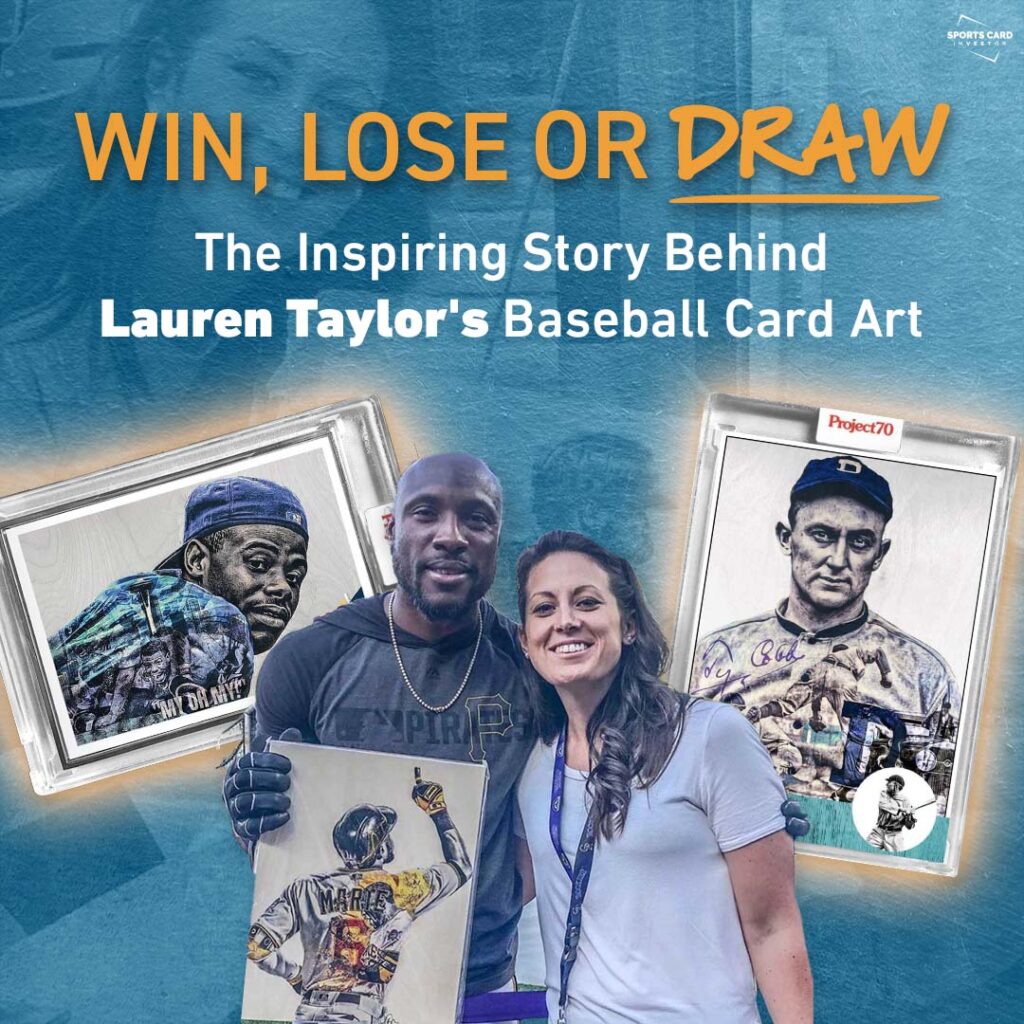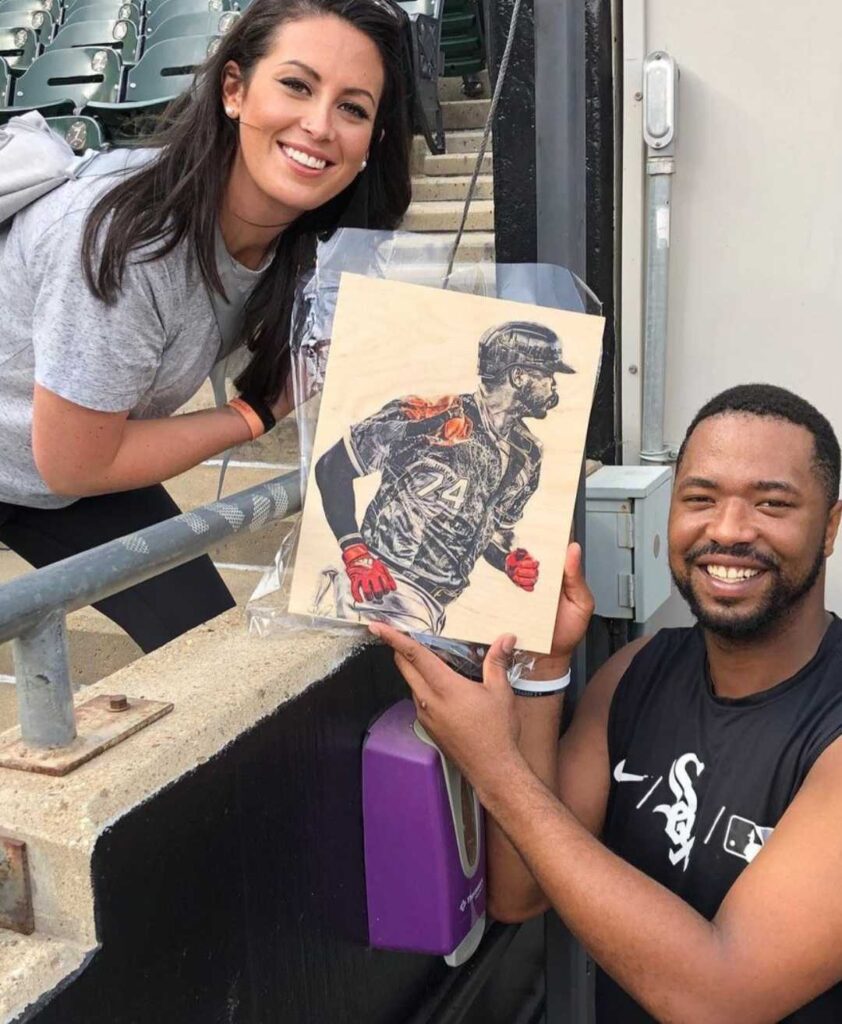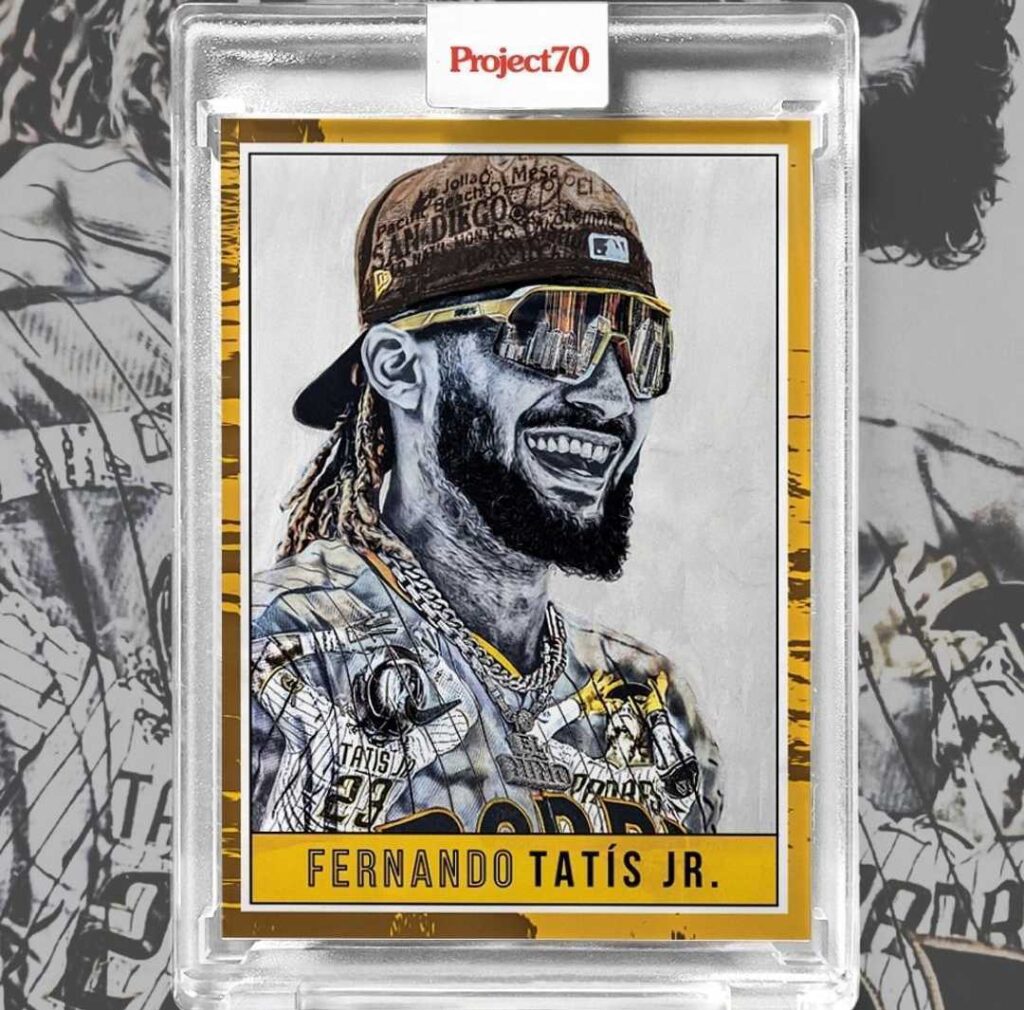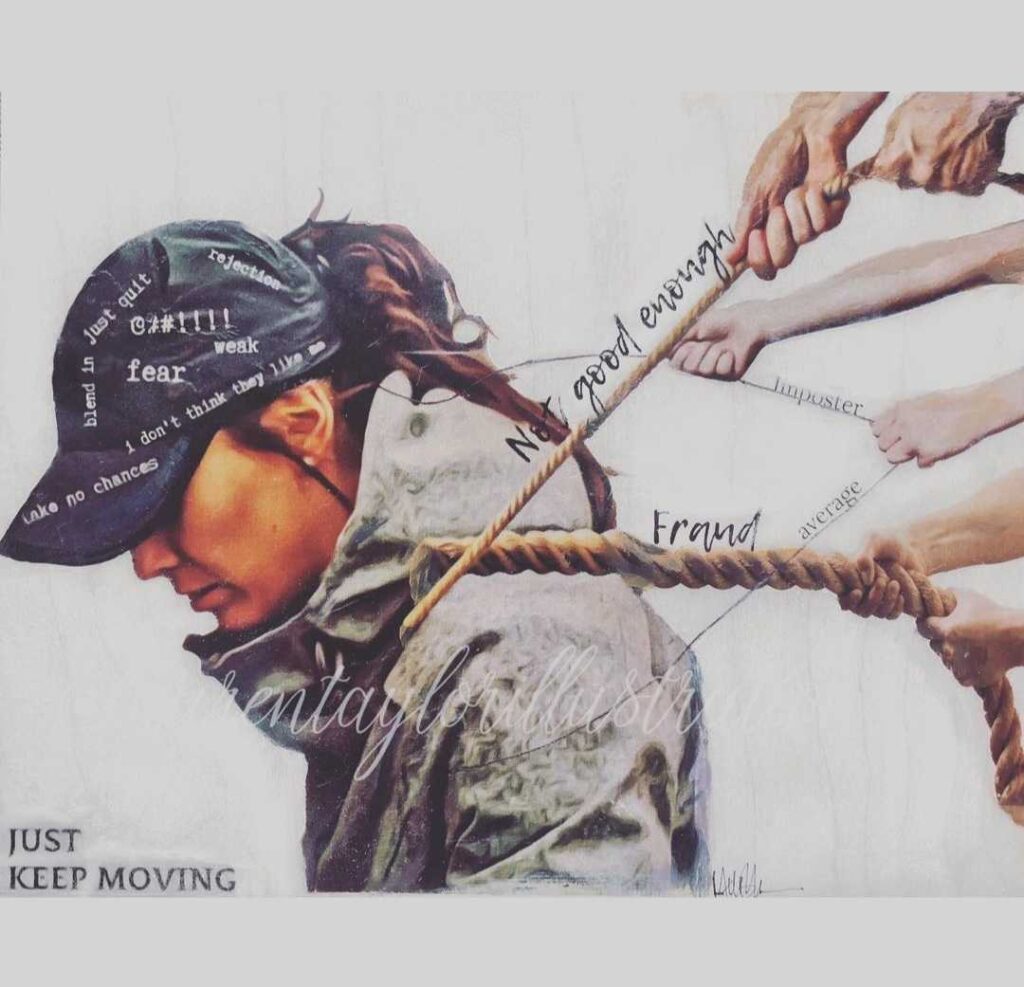
Win, Lose or Draw: The Inspiring Story Behind Lauren Taylor’s Amazing Baseball Card Art
What’s astonishing about Lauren Taylor’s art is how each piece is layered with so many different stories. You look inside one image and you’ll find another picture that might actually have a third subject somehow weaved in there as well. It’s all super intricate and painstakingly detailed. It’s easy to see why Topps selected her as one of the artists for its beloved Project 70 art-focused baseball card series.
But Taylor, who’s preparing her own 35-to-40-card set with Topps for release in the first half of 2022, will be the first to admit that her relationship with the famed card company hasn’t always been so solid. Topps initially dismissed her, calling her early artwork average at best. That ill-timed rejection came when the Seattle-area native was already dealing with the physical and psychological scars left by a freak softball accident.
Today, Taylor’s social media channels (@laurentaylorillustrations on IG) are filled with candid conversations about mental health as well as behind-the-scenes looks at her creative process. Sports Card Investor called Taylor a little while ago to talk about both and, as we expected, she was more than willing to peel back the layers and shed some light on it all.

How were sports introduced to your life?
Yeah, I grew up just outside of Seattle, in the San Juan Islands, a very small, small town. And, yeah, I’ve pretty much always loved sports. Baseball and softball significantly more than the others. I spent a lot of time focusing on that. That’s what brought me to play college sports as well, which was fast-pitch softball. But long before that, I was obsessed with the ‘90s Mariners. Growing up during that exciting time of [Ken] Griffey [Junior], Edgar [Martinez], Ichiro [Suzuki] and Joey Cora. There were so many fun athletes on that team. That really kinda sparked my love for baseball even more.
I fell in love with collecting cards, too. Used to collect cards with all the boys. I didn’t know what I was doing. I just wanted to get a Griffey card. Every Griffey card got a heavy case. I kinda thought I was gonna retire on my terrible ‘80s cards and ‘90s cards, which a lot of us probably thought. But yeah, I loved it then. We had a small card shop on the island. I used to collect the Becketts and look [up card prices] the old-school way, straight up in the magazine. It was something I did a lot of. I wasn’t the coolest kid. I kinda just did my own thing. And sports were a huge part of my life. How I did have social circles would be through sports.
Then that led me to continuing to play into adulthood. And then, I got hit with a line drive in the face. That was at third base. This was about five years ago. I broke my face and head in four places. I had hemorrhaged retinas and a significant brain injury. It just changed my life completely. I used to work for an investment company. And I found that my brain did not work the way that it used to. I’ve always struggled with mental health, and that was exacerbated after the head injury.
I kinda dabbled in art my whole life, but not seriously. And then after the injury, I couldn’t play. I was kinda trapped in my own mind. So, I started doing a bit of art in sports to feel like I was still in that world a little bit. That kinda seemed to scratch the itch a bit. I started doing more and more of it and found it was the thing I could focus on when I found I couldn’t focus on anything else. Yeah, that’s what started it. And then, you know, it was a snowball effect. I kept doing it and doing it and doing it. I got better and, fast forward a couple years later, I quit my job and now I do art all the time. If you told me this was gonna be my life, even seven years ago, I would have laughed at you. It’s been a wild road. The good and the bad have all been from baseball. And here I am.

The only logical next question is when does the movie based on your life come out?
I don’t know. Whenever Hollywood gives me a shout, I’m ready. I do want to write a book one day. Yeah, it’s a crazy story and a bit of a wild road, full of lots of ups and downs. And that’s why I’m adamant about advocating for mental health. I’m trying to use some of my profit from being an artist to benefit things like the suicide hotline, which I volunteered at for a while here. [I’ve been helping] various locations that need support because they’re all not-for-profit and need volunteers. I recognized how serious the need is for mental health services when I was 1,000% reliant on them for a while after my injury.
When you hear about concussions, you don’t think about the mental health part of it. At least I didn’t. For the first few weeks, I wasn’t thinking about that [the mental health aspect]. I was thinking about the fact that I could barely eat. I was always dizzy. I had migraines. I was waiting for fractures to heal in my face. It was pretty low on my list. I figured, “Of course, I’m a little bit down right now. My face is pummeled.” As the marks started to heal, that’s when things really kind of shifted and I was a different person. The worst I’ve ever been with mental health was that time span. I was so lost. Oh, my God, am I starting this road all over again? Is it ever going to go away? Is this something different? Not knowing how to talk about that, there’s some shame behind struggling again.
There’s also some shame [with thinking], “Okay, no one can see the injury anymore, but I am struggling worse than when my eyes were swollen shut.” So, I’ve been trying to talk about that openly with kids. Because, I think, a lot of times we see people online, on Twitter and all these different places doing really cool things—myself included. I feel like kids think what I’m doing is very cool. I’m very grateful. It is. But it’s important to me that they understand that you can still do it if you’re struggling. We just post our highlight reels. I try and be open and honest about that. As I create, sometimes I’m not okay. Sometimes the best you can do is just kind of work through it and ask for help. And yeah, be honest with ourselves about that.

Would you say that the art has helped in the healing?
Absolutely. When we’re athletes growing up and in college, [sports] is our identity. You get so wrapped up in that routine that, when it suddenly stops, you don’t really know who you are. And I was able to kinda transition into the art and still find an identity there. That eased the transition a bit. The more I got comfortable creating, the better I got at creating. I was able to start putting some of the thoughts I was having in my head that I didn’t know how to put in words through art. Obviously, there’s no baseball cards with my mental health [awareness on them], but there are things I post from time to time to kinda do a reality check with people and see how they’re doing, too. It tends to open them up a little bit. I feel like art’s been a huge benefit to me. It’s definitely one of the tools in my tool kit that I use often when I’m struggling.
It’s brilliant how your images have images, and those images have images in them. Talk a little bit about your creative process. How do you go about doing what you do?
That’s probably the reason I show so much of my baseball art to the world; it’s because I feel knowledgeable in that department. If I’m asked to do a soccer or football piece, I’m like, “Okay.” With soccer especially, oh God, I need to do some research. The way that I do baseball, I generally know a story about the player. I know of them. I kinda know their career. I know enough about them that it’s not starting with no education on that. And then I think of something that’s important. Oh, what’s the first thing I think of when I think of them? Or what’s the first thing I think about when I think of them? What is the legacy I think that they wanted to leave? You come across the legacy thing when you’re talking more about players like Jackie Robinson. When you’re talking about… Like I just recently did Edgar Martinez. When I thought of him, the double was the first thing that came to mind. I think it does for a lot of people. I was a kid in the ‘90s. Hearing [late Mariners broadcaster] Dave Niehaus on the radio was very exciting.
Then, I kinda work backwards. I want to have a pose of the athlete that kinda capitalizes on their character. So, I did the sick mustache of Edgar with the old jersey. Then, I ask, “How am I going to tell the story?” I want it to be visually appealing, even without the things within the jerseys. I start there. What story do I want to tell? The story of the double. So, I put in [an image of] him celebrating that. Then, I put the skyline in the background. He was kinda larger than Seattle in that moment. He spoke to all of us by beating the Yankees [in the 1995 ALDS]. What story am I hoping to tell with this one art piece? What memories do I want this to elicit for people? That’s kinda my hope every time I create.

Tell me a little bit about the connection to Topps.
Yeah, well, funny story. A little bit after my head injury, I’d say a year and a half, I was still struggling pretty intensely. I had started to do the sports art and I delivered a couple pieces to a couple athletes. Okay, maybe I got a shot at this. I wanted to do it the right way. I wanted to get licensed. After poking around there, people were like, “You need to try and get a hold of card companies.” I contacted every card company. With Topps, it felt like I was getting somewhere. I was like, “All right, this is looking good.” But it ended with an email that said a layman hobbyist could do what I do. It was the biggest crushing blow of anything I’ve ever done. It was just crushing at that point in my life, when I was already like, “What the hell am I doing?” It became a chip on my shoulder. I struggled for a couple of weeks. Maybe art wasn’t for me. Maybe I wasn’t as good as I thought I was. Maybe this was a lofty goal.
Three other card companies also said no thank you. But I was like, “Well, I’m gonna find a way. One day I’m gonna do this.” This was a couple of weeks after I’d had my pity party and wallowed in my sadness. How do I make my art stand out? And that’s when I started doing the images within, kinda telling a story within the jersey. I wanted to make sure “layman hobbyist” didn’t come up again. And if it did, at least I knew I was putting in so much work that even if a layman hobbyist could do it, they’d have to spend 10,000 hours working on it to get to where I was at. And that was my goal.
I just started working really hard. I forgot about Topps. I got licensed by MLB through Art of Words. They’re really cool. They do baseball prints with stats. They sublicensed me and I’ve been doing that ever since. I kinda forgot about Topps. It’s not for me. And then, Project 2020 came out. It was pretty cool but watching them get drubbed online for the first couple of cards [caused pause in me]. I told my business partner, “If they ever approached me to do it, I don’t think that I could. I don’t have thick enough skin. Some of these comments are brutal.” And then I got a call from Topps for Project 70. They approached me. I was all in. This is great. This [second experience with the company was] so much better. I’m glad I didn’t get it when I wanted it. It was way better to have been pushed to better my craft and feel that underdog feeling. It was better in every way. It was just one of those things that came full circle. And it was a really proud moment for me. I got through that rough patch. It took a few years, and it didn’t go the way that I had originally wanted, but it’s better this way. It’s been a good lesson, yeah.

Which cards tell the Lauren Taylor story the best?
Griffey, for sure. Griffey was my guy growing up. I was obsessed. I absolutely love that card. If you had told 10-year-old me I was going to be making a Griffey card one day, it just would have blown my mind. That was a really special and emotional drop. There’s also a tribute in there to a friend who lost her son in the hat. His initials are in there. So, that was a really meaningful card for me all around.
I’d have to say Lou Gehrig was pretty special, too. Because Gehrig was the first card I got to start doing some positive change that was bigger than the baseball card. I made a commitment to donate to ALS [after its release]. I also said if I hit a certain print run, I’d donate an additional amount. That inspired other people to donate. And then, those people would match other people’s donations. It became something that was bigger than me. You can’t ask for more than making something and wanting to do it for collectors and for fun, but then it turns into something that betters the world in some small way. The Gehrig and Griffey are two special ones, for sure.
What can you tell me about your solo box set that’s coming out this year?
Yeah, I am pretty excited about it. It’s a lot of art. I’m giving it the full Lauren Taylor package. I’m not cutting any corners here. It’s gonna be fun. I can’t tell you much but to stay tuned for more details. There will be more new players. Obviously, for current boxes that go for sale, you don’t get as many of the older players. You’re looking more for rookie cards and some of the current players. So, you’ll see more of that. With Project 70, I started doing more older players because I wanted to have a platform for that art and leave room for other things. There may be some duplicate [players]. Obviously, a Mike Trout will likely happen in my box set as well. It’s gonna be fun. It’s gonna be a big undertaking. It’s something I’m really proud I get to do. It was kinda my goal from the second I got signed to do Topps. When I was asked to do it, I was really excited. The things that I had bought and collected as a kid, I now get to be the one creating them. When you stop and think about, it’s pretty cool.
Track your collection and maximize your profit with Market Movers, the hobby’s most powerful sports card pricing platform! Learn more here.
Note to readers: If you purchase something through one of our affiliates, we may earn a commission.






